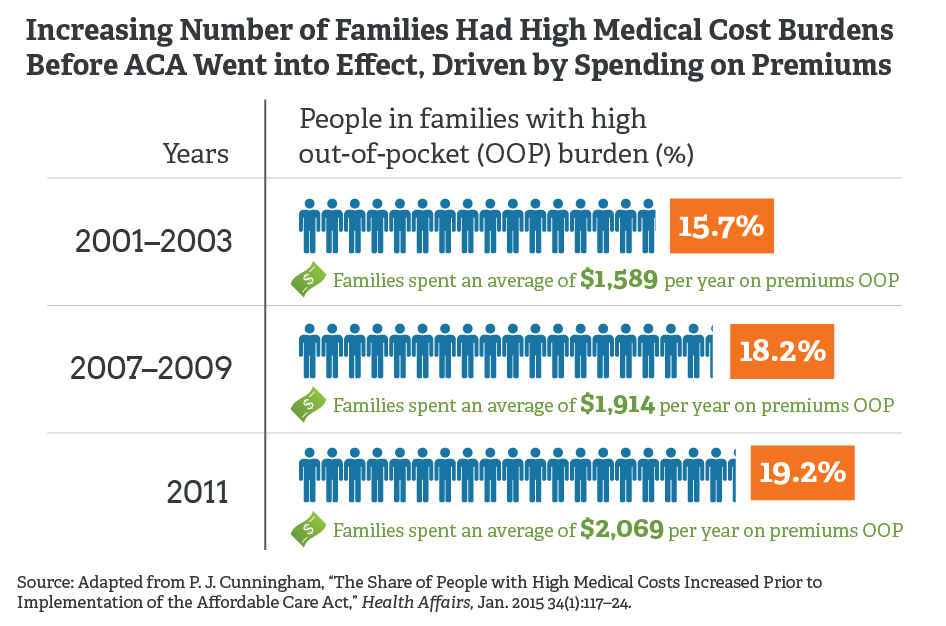Synopsis
The percentage of Americans who spend more than 10 percent of their family income on out-of-pocket health care expenses increased to 19.2 percent in 2011, from 18.2 percent during 2007–09. Medical cost burdens were highest for people with private nongroup insurance coverage, who are among those most likely to benefit from the Affordable Care Act’s coverage expansions.
The Issue
In addition to providing access to health insurance for many of the uninsured, the Affordable Care Act is helping to make coverage more affordable than it was previously for many individuals and families, particularly for those with nongroup coverage. With risk spread broadly among those participating in the insurance marketplaces, premiums have generally been kept in check. Subsidies have minimized costs for people with lower incomes, while individuals with serious health problems have been protected by rules restricting insurers from charging higher premiums or denying coverage altogether. Such provisions could help narrow the affordability gap between those with employer-provided coverage and those buying insurance on their own. This Commonwealth Fund–supported study examines medical cost burdens for people younger than 65 for 2010–11, just before the health reform’s major coverage provisions went into effect. The analysis looks at people with different types of coverage—or none at all—and at spending for a variety of services, like physician visits or hospital care.
Key Findings
- In 2011, 19.2 percent of Americans under age 65 had high medical cost burdens—meaning they spend more than 10 percent of their family income on out-of-pocket expenses for health care. That was up from 18.2 percent during 2007–09.

- The increase in cost burdens was concentrated primarily among people with employer-sponsored coverage, mainly owing to their higher premium costs. Average spending on premiums by people with employer coverage rose from $2,592 in 2007–09 to $2,838 in 2011.
- Medical costs burdens were highest for people with nongroup private insurance. In 2011, 48 percent of Americans with this kind of coverage had a high cost burden. Family spending on premiums by people with nongroup coverage averaged $5,799 in 2011.
- Sixteen percent of individuals with public coverage had high out-of-pocket cost burdens in 2011, compared with 20.1 percent in 2001–03. Among the uninsured, 14 percent were in families who had high out-of-pocket burdens in 2011—unchanged from 2001–03. Many uninsured people forgo medical care to avoid health care bills.
- Out-of-pocket spending on prescription drugs fell from $203 to $172 per person between 2007–09 and 2011, driven mainly by a shift from brand-name medications to less expensive generics. Many new generics became available during the 2009–11 period, including drugs to treat attention deficit hyperactivity disorder, schizophrenia, depression, and early-stage breast cancer.
The Big Picture
“[M]any people with nongroup coverage before 2014 will be able to dramatically lower their health insurance and health care spending through the marketplaces,” researcher Peter Cunningham concludes. Just over half of people with nongroup coverage in 2009–11 had family incomes at or under 400 percent of the federal poverty level, making them potentially eligible for the marketplaces’ premium subsidies and a substantial reduction in their cost burden. For instance, adults in families with incomes between 138 percent and 250 percent of poverty spend an average of $5,435 for coverage; buying coverage through the marketplace could reduce that price tag by two-thirds, to $1,797.
About the Study
The analysis was based on data from the 2001–11 Medical Expenditure Panel Surveys (MEPS), sponsored by the Agency for Healthcare Research and Quality. Family medical cost burden was defined as the ratio of total out-of-pocket spending for health care services and premiums to total family income. People who spent more than 10 percent of family income on health care were identified as having a high cost burden.
The Bottom Line
The percentage of people with high medical costs burdens increased from 2007–09 to 2011, with burdens highest for people with private nongroup insurance. The Affordable Care Act’s coverage provisions are likely to substantially reduce these cost burdens for many people.



